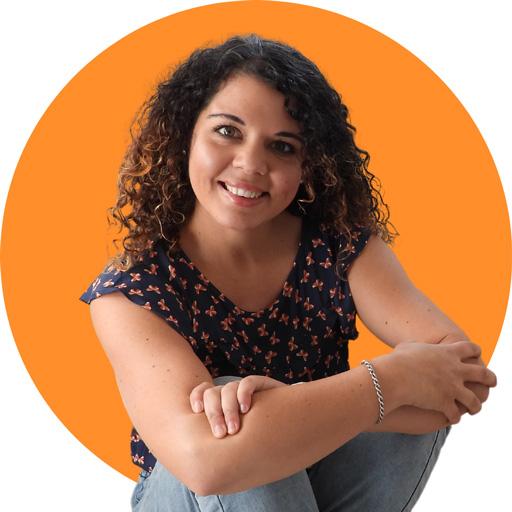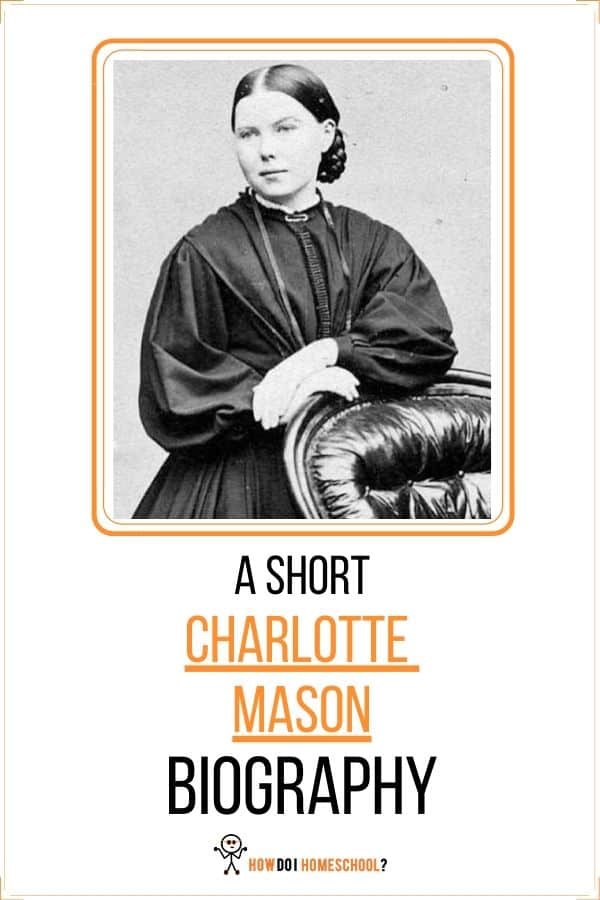Who was Charlotte Mason? The Charlotte Mason biography is the story of a girl who was homeschooled and loved it. She loved homeschooling so much, she became a Classical educator and taught many pupils. Mason was a keen observer of human nature and understood the unique connection between mother and child. She shared her insights in a series of home education books and publications for school teachers.

I hope you enjoy reading this blog post. If you want to do my course on how to homeschool, click here.
Her publications, written in the 1800s, tell readers what life was like in those times. They show the upper-class lifestyle Mason was familiar with. Nevertheless, she always had time for the weak and poor, showing others the importance of ‘liberal’ education for all – even the poor maid’s daughter or the orphaned chimney sweep.
Also a keen observer of nature, Mason encouraged students to connect with the outside world. She also encouraged short lessons and perfect copywork, expecting a high standard from pupils.
But, let’s not get ahead of ourselves too soon. In this Charlotte Mason biography, we’ll cover:
- Who was Charlotte Mason
- Her Early and Later Life
- Tenets of a CM Education
- Charlotte Mason vs. Montessori vs. Classical Education
- The Books She Wrote and
- Charlotte Mason Curricula
Let’s get started!
Some of the links in this post are affiliate links.
Who was Charlotte Mason?
Charlotte Mason was an English educator who lived from 1842 to 1923 (80 years). Trained in Classical education, Mason believed education should be more gentle and individualized to give children a better learning experience. She also thought education should be available to the masses and should be a rich feast of ideas (something she called ‘liberal,’ which in the 1800s meant broad-ranging.)
The Early Life of Charlotte Mason
Born in Wales, Mason was homeschooled by her parents. As an only child, she had an excellent education as her parents presented her with a broad range of ideas and concepts.
Mason never married.
Later Life of Charlotte Mason
Charlotte Mason spent ten years teaching at the Davidson School in Worthing. During this time, she thought about the need for a richer (or more liberal) education for all children, no matter their station in life.
Mason also worked on her popular Ambleside Geography books for more than ten years, from 1880.
Soon she began to lecture at a teacher’s college called Bishop Otter Teacher Training College. Her lectures were later published as a series of books called the Home Education Series.
Charlotte Mason’s Death
Charlotte Mason died in 1923 after reaching her 80th year. She was much loved, and many were sad at her parting.
They engraved the following words on her tombstone:
In loving memory of Charlotte Maria Shaw Mason, Born Jan 1, 1842, died Jan 16, 1923,
Thine eyes shall see the King in His beauty. Founder of the Parents National Educational Union, The Parents Union School, and The House of Education. She devoted her life to the work of education, believing that children are dear to our Heavenly Father and that they are a precious national possession.
Education is an atmosphere, a discipline, a life.
I am, I can, I ought, I will.
For the children’s sake.
These are beautiful words for a lovely lady.

Charlotte Mason’s Theology
Raised in the Anglican church, Mason was a strong Christian. Her strong faith is evident in all her books.
Indeed, she believed educational theory should be based on Christian theology, and families should be led by the Holy Spirit.
Also, when students come to a book or text, they should ask the Holy Spirit to help them understand it.
Scouting
Thanks to Charlotte Mason, we have Boy Scouts and Girl Guides today. Mason believed nature was a competent teacher. It has the power to amaze children and interest them, creating an excellent opportunity for interest-based education and observation.
She was the first person in modern history to recognize the educational potential of scouting.
Nature Walks and Nature Appreciation
There is plenty to look at in the wild, on bushwalks, or even at your local park. Mason also encouraged educators to take their students on nature walks. Nature walks are outings into nature to observe and engage with nature. You can see the video below for more on nature walks.
Tenets of a Charlotte Mason Education
There are some elements in a Charlotte Mason education that are somewhat unique when compared to traditional or modern education. These elements are:
- Education should be through living books (fun educational books – sometimes storybooks – that teach children through stories and hold their interest more than dry textbooks)
- Learning should be gentle and seamless with other aspects of our life, rather than represented in a rigid curriculum
- Guided discovery (i.e., when on nature walks) with parents assisting children when they ask
- Good habit training – a focus on developing children’s character
- Short Lessons – very short lessons where children are expected to pay attention and do very good/perfect work
- Nature Walks – parents take children out and discover nature together. They notebook their discoveries and sketch etc
- Grow the mind and grow the person
- Narration – test children by getting them to recite what they learn orally
- Dictation
- Perfect copywork
You can find out more about these elements here.
Charlotte Mason vs. Maria Montessori
Many people wonder if Charlotte Mason education is different from Maria Montessori education. They are very different.
Using brevity that won’t do both methods true justice, here are some brief differences and similarities:
- Differences
- A Mason education encourages more reading, character formation, and gentle direction by parents; Montessori educators encourage children to teach themselves more.
- Montessori believed children should have child-sized furniture, cleaning equipment, kitchenette and cooking implements. There is a big focus on getting children to clean up after themselves and be neat, coordinated, and controlled with everything they do.
- Mason’s method is inherently Christian and assumes a Christian worldview. This is apparent in her books. In comparison, Montessori was a Catholic, but now most Montessori schools are secular.
- Similarities
- Both curricula encourage a connection with nature
- Compared to traditional education, these methods promote education through hands-on learning, more
Charlotte Mason education is much more popular among homeschoolers. Perhaps this is because her theory is more developed and more Charlotte Mason homeschool curricula are available.
If you want to know more about these methods of education, click the following links: Charlotte Mason; Montessori.
Charlotte Mason vs Classical Education
As you can see in this Charlotte Mason biography, Ms Mason was trained in Classical education. It seems classical education was a springboard for the formation of her own method of education.
Again, using brevity that won’t do both methods justice, here are some brief differences and similarities:
- Differences
- Classical curricula divide learning into three areas – grammar, logic and rhetoric. CM does not.
- Classical education is generally deemed to be more rigorous than CM education
- Fine arts are studied more in a CM education
- Latin and other languages are encouraged much more in a classical education
- Classical education studies writing composition as a separate subject; CM will incorporate it into other subjects later but prefered oral narration for testing and comprehension in the early years
- Compared to Classical methods, Mason prefered parents to wait until children ask a question in order to pique interest; Classical methods advocate for more parental explanation
- Mason has more of a focus on interaction with nature and good habit formation for developing character
- Classical education uses harder texts (and some might say more boring texts) like the old Greek classics (Illiad and the Odessey); Mason uses living books and believed texts should be absorbing and capture the interest of students
- Classical education has more rote learning
- The logic and rhetoric stage of classical education teach formal logic and debating
- Similarities
- Both methods expect a high standard of students, although Mason expected perfect copywork
- Learning of scripture, poetry, and songs are encouraged but moreso in classical education. Memorization was used a little more in classical education.
Charlotte Mason and Classical education are the most popular homeschooling methods used in homeschools these days (especially in America). Check out these two articles to learn more about both methods of education: Charlotte Mason; Classical Education.

Books Mason Wrote
An avid writer, Mason wrote plenty of books, many centred around her love of education. Her bibliography includes the following titles:
- Ourselves
- Home Education
- School Education
- Parents and Children
- Philosophy of Education
- Scale How Meditations
- Elementary Geography
- Elementary Geography: Book I for Standard II
- The British Empire and the Great Divisions of the Globe: Book II for Standard III
- The Counties of England: Book III for Standard IV
- The Countries of Europe Their Scenery and Peoples: Book IV for Standard V
- The Old and New World: Asia, Africa, America, Australia: Book V
- Formation of Character and
- Poetry: The Savior of the World
Inspired Curricula
Conclusion: Who was Charlotte Mason?
So, who was Charlotte Mason? When I think about her, I think of a compassionate, Christian woman who loved her pupils and had a heart for parents and educators alike. Mason had a great appreciation of nature and encouraged schools and homeschools to immerse their students in God’s amazing creation. She also believed in habit training and the power of a good book in the role of teacher. But, if I were to summarise her in a nutshell, I’d say Charlotte Mason was an amazing woman.



